Bird watching in Saint Lucia. What to see, where and when.
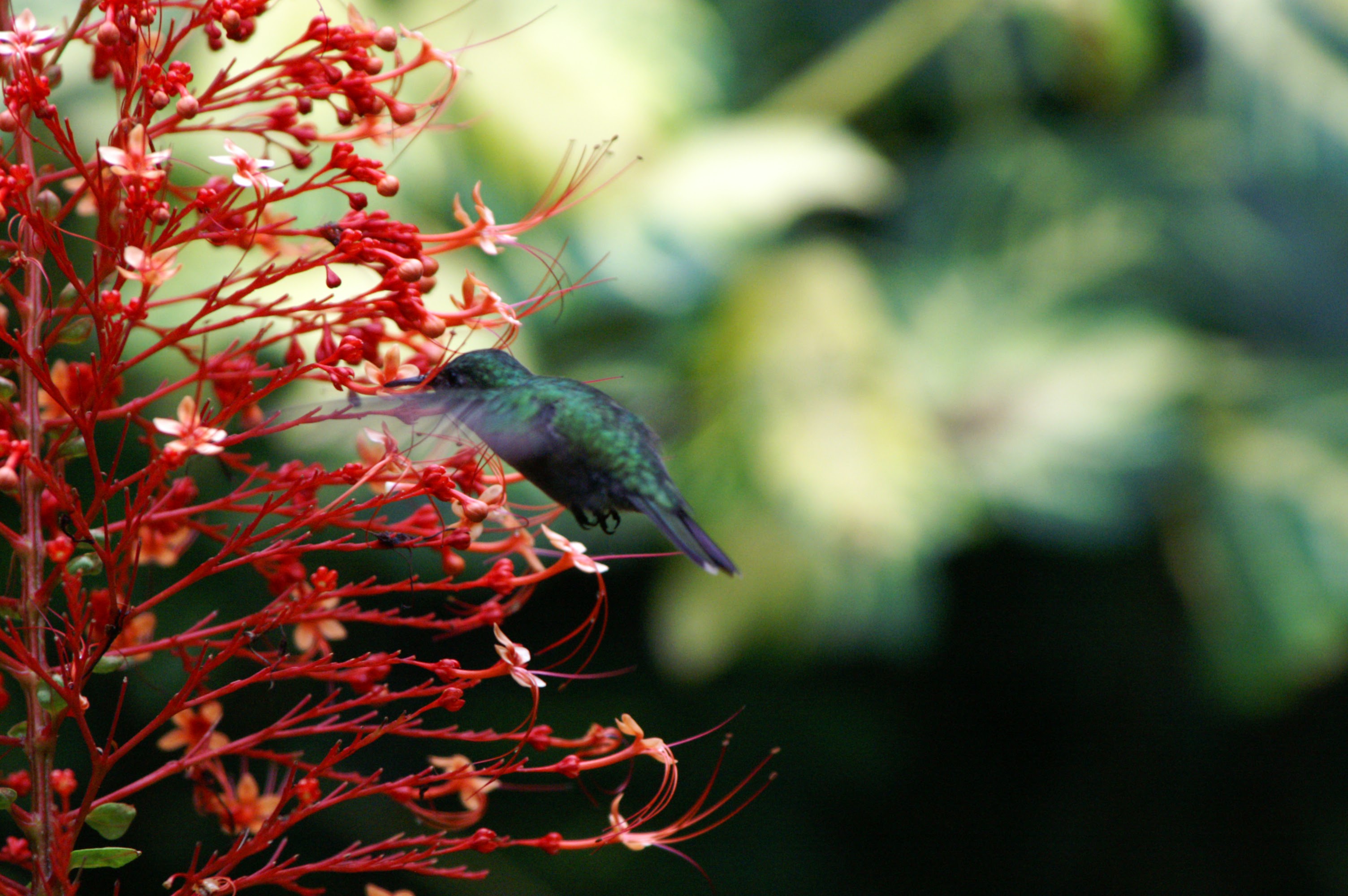
Saint Lucia, a small island nation located in the eastern Caribbean, is a hidden gem for bird enthusiasts. With its diverse range of habitats, including rain-forests, coastal wetlands, and mountain ranges.
Saint Lucia is home to over 170 bird species, including the Saint Lucia Parrot, the island's national bird, the Saint Lucia Black Finch and many others which are endemic or rare.
Table of Contents
The best time to visit Saint Lucia for bird watching is from November to May when the island experiences its dry season. During this time, bird sightings are more common.
What are the best bird watching spots in Saint Lucia?
Millet Bird Sanctuary: Located in the north of the island, Millet Bird Sanctuary is a popular bird watching destination that is home to more than 30 species and offers a chance to spot several bird species, including the White-breasted Thrasher, Antillean Crested Hummingbird, the Lesser Antillean Flycatcher and the St. Lucia warbler.
Below: American Kestrel in Saint Lucia.
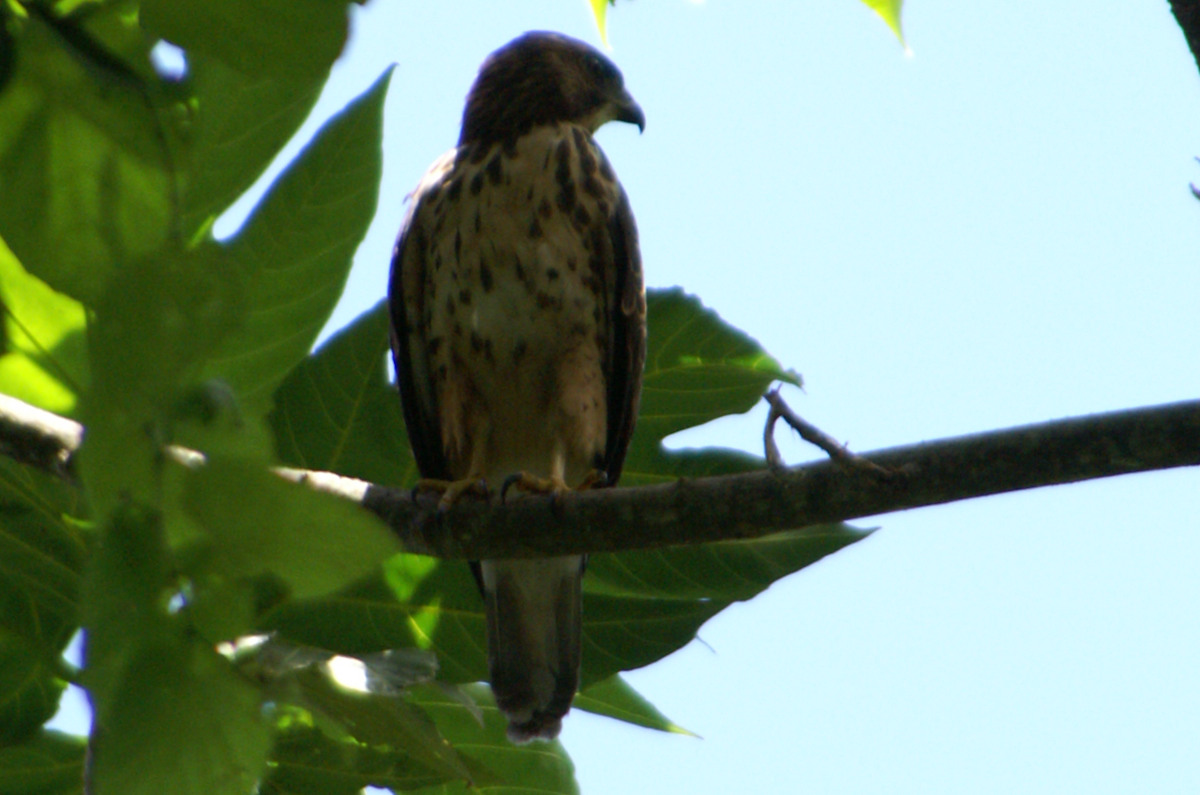
Another popular bird watching spot is the Barre de l'isle Forest Reserve. This reserve is home to several bird species, including the St. Lucia oriole and the St. Lucia pewee.
The Des Cartiers Rain-forest Trail is a popular hiking trail in this reserve and provides an excellent opportunity to spot these birds.
Edmund Forest Reserve: This rain-forest reserve is located in the south of the island and is home to several endemic bird species, including the Saint Lucia Parrot, Saint Lucia Oriole, and Saint Lucia Pewee.
Mamiku Gardens: A large botanical garden known for a wide variety of bird life.
Pigeon Island National Park: This historic park is located on the northwest coast of the island and is home to several bird species, including the Brown Pelican, Magnificent Frigatebird, and the Caribbean Martin.
Below: The little blue Heron at Pigeon Island.
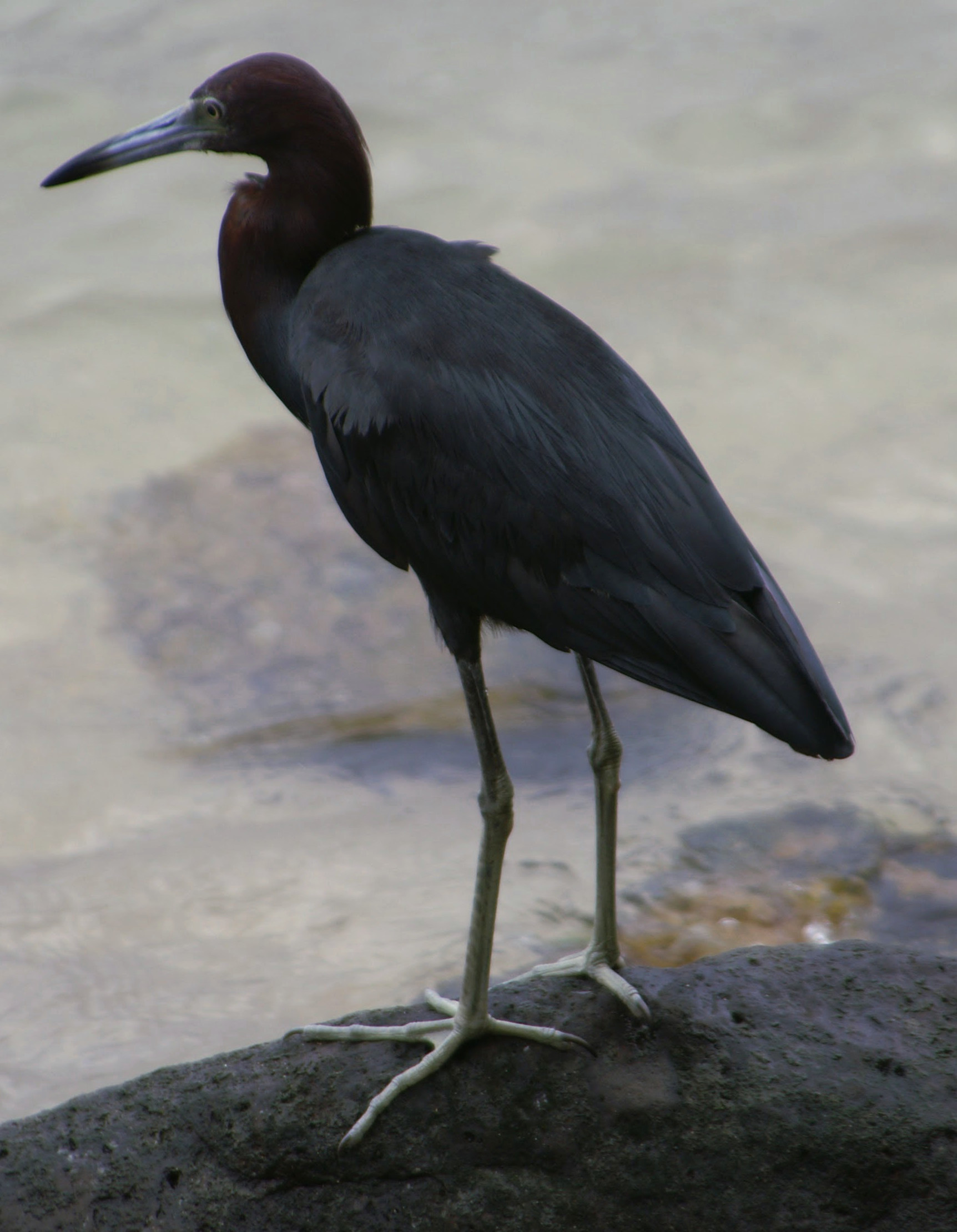
Bird watching tours: There are several bird watching tour companies in Saint Lucia that offer guided tours to the best bird watching spots on the island. These tours are led by experienced guides who are knowledgeable about the bird species on the island.
When going on a bird watching trip to Saint Lucia, it is recommended to bring binoculars, a camera, sunscreen, insect repellent, and comfortable walking shoes.
The Saint Lucia parrot " Jacquot".
The St. Lucia parrot is the national bird of Saint Lucia. Affectionately known locally as “Jacquot,” it is the best known St. Lucian endemic bird species.
Length: 42–46cm (16.5–18 in). Like other members of the parrot family, its feathers are mainly green, with iridescent patches of bright red and blue on the edges of its wing. It also has splashes of dark red on its chest and light blue on the top of the head. The St. Lucia Parrot is perhaps one of the most colourful of the entire genus of Amazona parrots, hence the species name versicolour. It is one of the largest birds in St. Lucia.
A few years ago, the St. Lucia Parrot was in danger of becoming extinct. In 1979, the parrot was made the National Bird of St. Lucia. In addition, nature conservation policies adopted by the Forestry Department have resulted in a remarkable change in the fortunes of the forest reserves and Saint Lucia Parrot. The Department’s Environmental Education Campaign has ensured that public concern for the St. Lucia Parrot has reduced the incidence of deforestation, hunting and other illicit activities in the forest reserves to near zero and provides a springboard for protection and conservation of our national bird.
The parrots’ habitat is primarily moist forest in the mountains, but it can also occur in the secondary forest and cultivated areas. They travel considerable distances to feed in the forest canopy on a wide variety of fruits , seeds, flowers and sometimes insects. The parrots roost deep in the forest, flying out to the edges to forage during the day, where they can be seen in the Quilesse, Edmund Forest, Millet and Castries Waterworks Reserve.
The breeding season is primarily from February to May. The parrots nest in cavities of tall trees where the adult female lays two or three white eggs deep inside a hollow tree trunk.
Parrots usually mate for life. If one of the pair dies, it may be years before the survivor finds another mate. Parrots do not sing. They fly to their feeding grounds early in the morning and return home late in the afternoon. As they fly, their loud screeching echoes through the forest making them very easy to identify.
Bird species in Saint Lucia:
Saint Lucia Parrot: This endangered parrot is the national bird of Saint Lucia and can only be found on the island. It has a bright green plumage and a red forehead, making it a popular bird to spot on bird watching trips.
Below: A brown Booby in the air over Pigeon Island.
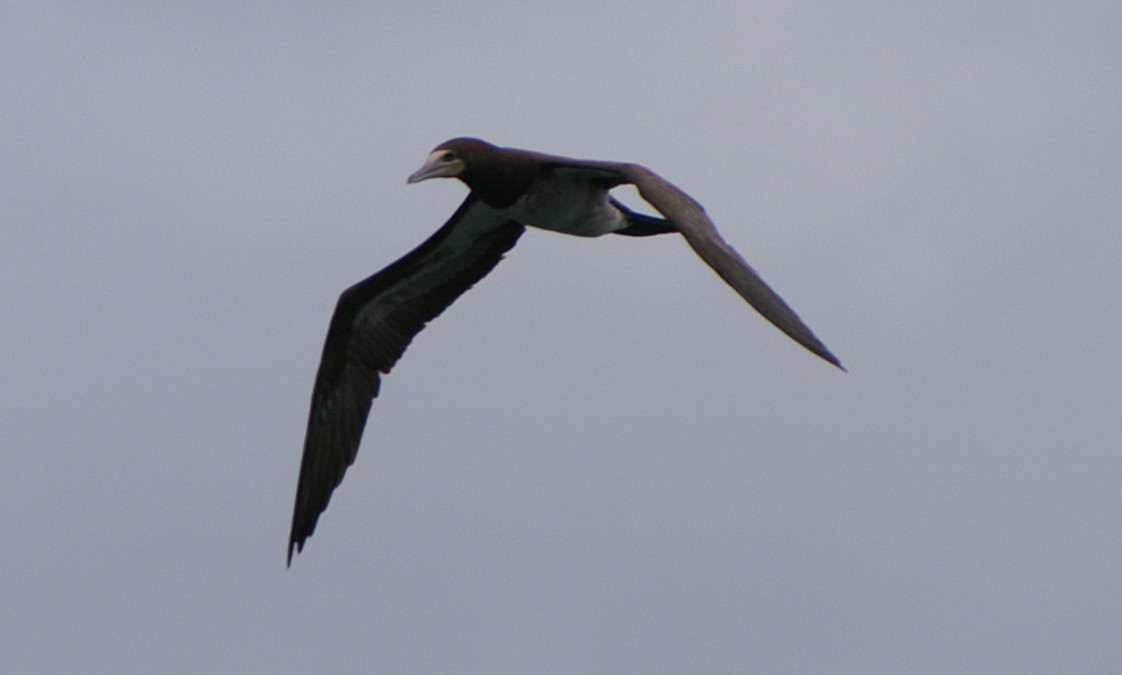
Saint Lucia Black Finch: This endemic bird has a black plumage and can be found in the forested areas of the island.
White-breasted Thrasher: This bird has a distinctive white breast and a greyish-brown plumage. It is commonly found in dry forested areas of the island.
Below: Vervain hummingbird in my garden.
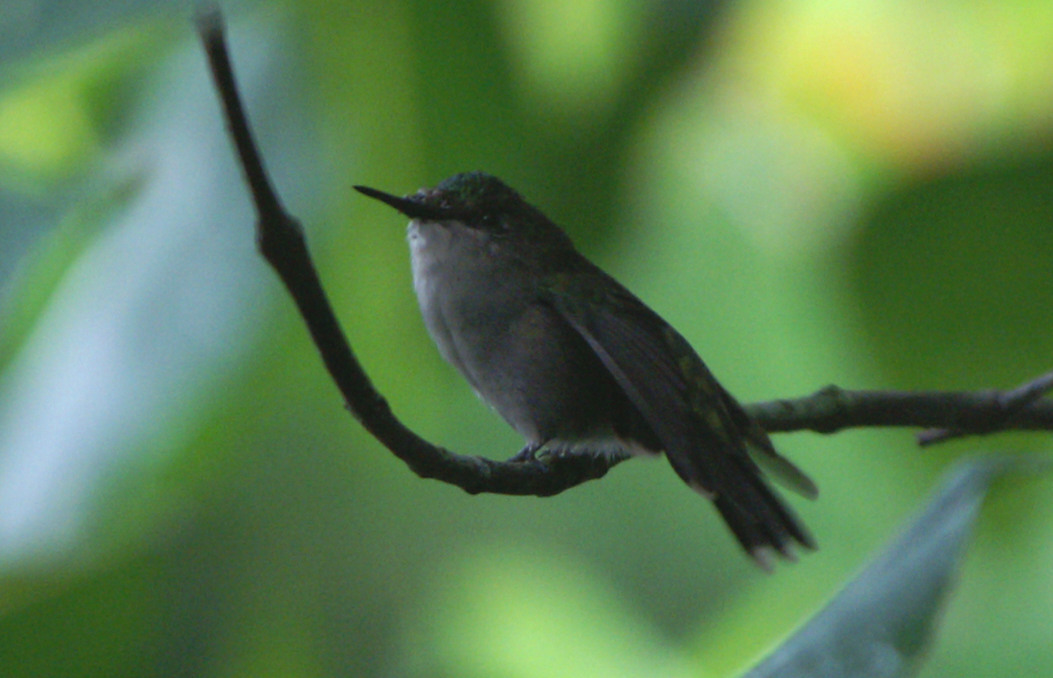
Antillean Crested Hummingbird: This tiny bird has a green and blue plumage and is found in the rain-forests of the island.
Saint Lucia pewee: Length: 15 cm (5.75 in). Our pewee is a small flycatcher (hence the local name Gobe-Mouche), with dark olive-brown upper-parts and reddish-brown underparts. It is a very timid bird that is often seen in openings in the forest under-story where they sally for insects. The call is an emphatic rising pree-e-e and a high-pitched peet-peet-peet.
The St. Lucia Pewee is a very common bird that can be found in a wide range of forested areas from the coast to the interior of St.Lucia. Its habitat is primarily moist forest at high altitude but less commonly in lower altitude and dry areas. They generally occur in the forest under-story.
The nest is a cup made of leaves, lichens and moss placed on a branch. The female lays two dark cream-coloured eggs, heavily spotted with brown. The breeding season is May and June.
Saint Lucia Warbler: Local Names: Chic-chic, Sequia Ba bad. Length: 12.5 cm (5 in). This is one of two St. Lucian endemic warblers. It can be distinguished by its bluish-grey upper-parts; yellow throat and breast; yellow eyebrow stripe; and black crescent below the eye. The voice is a loud trill, variable in pitch and speed. They occupy a wide range of forested habitats, primarily at middle and high elevations. They feed actively, gleaning insects and spiders from leaves and twigs.
St. Lucia Warbler is a very common year-round resident in the Quilesse, Edmund Forest, Millet, Union and Castries Waterworks Reserve, and also on western and eastern coasts of St. Lucia.
The nest is a finely woven cup built in a tree or dense thicket from 0.2 m to over 6 m above the ground. The breeding season is from March to June, when the females lay three to four white eggs, flecked with reddish-brown spots.
Semper's warbler: Probably extinct. Local Name: Pied-blanc (“white-foot”) Length: 14.5 cm (5.75 in). Semper’s Warbler is one of two warblers endemic to St. Lucia.
Saint Lucia Black Finch: Local name: Moisson Pied-blanc. Length: 13–14 cm (5–5.5 in). The St. Lucia Black Finch can easily be mistaken for the Lesser Antillean Bullfinch, Loxigilla noctis at first glance. However, the male black finch does not have a patch of red on its throat like the bullfinch. The female can be recognised because the top of the head is grey, not brown as the bullfinch. Also, both male and female have pink legs and they bob their tails vertically. The vocalisation is a burry tick-zwee-swisiwis-you with the accents on the second and last notes.
The St. Lucia Black Finch is often found in pairs in both moist and semi-arid forest to 700 m. Like most finches, the black finch eats seeds and berries as well as some fruits. The breeding season is from November to June. The female usually lays two white eggs with evenly spaced brownish-red spots. The nest is loosely constructed of twigs, rootlets, ferns and leaves, with an oval side entrance, usually built in a shrub or small palm up to 3 m (10 ft.) above the ground.
Saint Lucia Oriole: Local Name: Carouge. Length: 20–22 cm (8–8.5 in). The St. Lucia Oriole belongs to the family Icteridae, the same family as the Carib Grackle or Merle. The adult is black except for the lower back, rump, shoulder and lower belly which are rich orange or orange-yellow. The adult female is similar to the male, but orange-yellow is duller; the immature is mostly greenish with a blackish throat.
St. Lucia Oriole is an uncommon species that can be found in both rain-forest and in fairly dry scrubby areas near the coast. The breeding period is from April to July. The nest is a well-made basket woven of grass and fibre. It is usually hung from large leaves. In it the female lays three white eggs with dark brown spots.
Like most birds, the orioles are good parents feeding and protecting their young until they are ready to fly away from the nest. In St. Lucia, orioles are susceptible to man-made and natural disasters such as hurricanes, pests and diseases, deforestation, aerial application of agricultural pesticides, hunting, etc. An additional and major threat to the oriole population is the brood parasite, Shiny Cowbird or Merle Bar Bade, which lays its eggs in the oriole nest, and is reared by the orioles instead of their own rightful young. This is a serious problem affecting the St. Lucia Oriole, and difficult to manage or control.
Rufous Nightjar: Local Name: Jacques-pas-papa-pouw. Length: 28 cm (11 in). The St. Lucian endemic subspecies of Rufous Nightjar* is a medium-sized bird, dark overall with some reddish-brown edges on its feathers and short, rounded wings. It is nocturnal (active mainly during the night) hence the name “nightjar.” The voice is vigorous and loud, seemingly recalling its local name of Jacques-pa-papa-pouw. The call is most often heard at dusk and only during the breeding season, which is May and June. The nest is a scrape on the ground in which it usually lays two white eggs with light brown spots.
The Rufous Nightjar is endangered in St. Lucia. Its population is now very small due to loss of habitat and predation by dogs, cats, mongooses and pigs. It is nocturnal, occurring in the northeast from Grand Anse south to Dennery, and also Anse La Raye. Coincidentally, the places where the Nightjar is now found are also places where there is a high concentration of the deadly Fer-de-lance, a conservation blessing that we should appreciate.
Lesser Antillean fly catcher: Local Name: Pipirite Gros Tête. Length: 19–22 cm (7.5–8.5 in). This endemic subspecies can be distinguished by dark olive-grey upper parts, mostly yellow underparts from upper belly to under-tail coverts, and tail feathers with reddish inner webs. The voice is a loud, plaintive whistle peeu-wheeet and also a short whistles oo-ee, oo-ee, or e-oo-ee.
Lesser Antillean Flycatcher is a rare and elusive bird in St. Lucia, primarily found in the transition forest at medium elevation and in the rain-forest in the interior of the Castries Works Reserve, Quilesse, Edmond Forest and Millet areas. The local name refers to the large head (“Gros Tête” in the French Creole language) in proportion to the rest of its body.
The breeding season is from March to July. The nest is made of loose plant fibres, feathers and plant down is built in a tree cavity, where the female lays 3 to 4 creamy buff eggs, heavily spotted and scrawled with purplish-brown and violet-grey.
Saint Lucian Wren: Local name: Rossignol. Length: 11.5–13 cm (4.5–5 in). The St. Lucia Wren is considered an endemic subspecies of the House Wren. It is a small, active brown bird with a large head relative to body size. The St. Lucia race is slightly paler below than the St. Vincent and Dominica races. The song of the wren is a bustling, gurgling warble compared to other birds.
The breeding season is May to August. The female lays two to six whitish eggs, heavily speckled brownish-red.
Similar to all of St. Lucia’s endemic birds, the wren is threatened by the loss of its forest habitat. It is now confined to the northeast coast of St. Lucia and Gros Piton. The decline of its population is also related to predation by rats, mongooses, etc. Brood parasitism by the Shiny Cowbird is also a major threat to the wren’s survival.
White breasted thrasher: Local Name: Gorge Blanc.
Length: 23–25cm (9–10 in). The upper parts are dark brown with contrasting white underparts and long, slightly down-curved bill. It often droops its wings and may twitch or flick its wings when excited or curious. The immature bird is dark brown, developing a creamy white patch on the breast as it ages. This subspecies is endemic to St. Lucia.
The White-breasted Thrasher is very rare and critically endangered, restricted to the northeast coast from Prasline in the east to Petite in the north. The global population is just 1250 breeding adults, 80% of which live in coastal scrub and dry woodland along the northeast side of St. Lucia. The habitat is dense thickets of semi-arid, wooded stream valleys and ravines. It is now on the IUCN Red List as a result of habitat destruction due to resort development, urbanisation and charcoal burners. Other threats include rats, mongooses, and Boa Constrictors which prey on juveniles. Young thrashers spend much time on the ground before fledging; they are noisy and attract terrestrial predators. White-breasted Thrashers primarily forage on the ground, tossing aside leaf litter in search of small invertebrates. They feed to a lesser extent on berries, fruits, small lizards and tree frogs.
Scaly breasted thrasher: Local Name: Grieve
Length: 23cm (9 in). Scaly-breasted Thrasher is a very shy bird distinguished by white underparts heavily scaled with greyish brown from throat to belly, a single whitish wingbar, black bill, yellow-brown iris, and tail tipped with white. It may be confused with Pearly-eyed Thrasher which is larger with a large, yellowish bill, no wingbars and different belly pattern.
Scaly-breasted Thrasher is common year-round in St. Lucia where it can be found in both moist and semi-arid forest and woodlands. The nest is a rough cup-shape, built in a tree, in which the female lays two or three greenish-blue eggs. The breeding season is May and June.
Gray Trembler: Local Name: Trembleur
Length: 23–26cm (9–10 in.) The Gray Trembler has dark grey upperparts, pale, whitish underparts with whitish throat. Some individuals are greyish-beige below. The iris is yellow. The bill is very long and slightly down-curved near the tip. It characteristically droops its wings and trembles when searching for insects in cracks in tree bark and other vegetation. Vocalisations include wavering whistled phrases, harsh scold and call notes.
Gray Trembler occurs at all elevations and can be seen in both moist and semi-arid forest and woodlands in St. Lucia. It is a Lesser Antillean Regional Endemic; St. Lucia and Martinique comprise its entire range.
Pearly eyed Thrasher: Local Name: Gross Grieve
Length: 28–30cm (11–12 in). This is the largest thrasher on the island. The upperparts are light brown; the underparts are white, streaked with brown. It can be distinguished from the Scaly-Breasted Thrasher by its white eye, yellowish bill and large white patches on the tail tip. Forest Thrush is darker brown, has yellow skin around the eye, yellow legs and lacks tail spots. Pearly-eyed Thrasher’s vocalisation is a series of one- to three-syllable phrases (e.g. pio-tareeu-tsee) with fairly lengthy pauses separating them. It often sings well into the day and during clear nights. It also has many raucous call notes, including a guttural craw-craw and a harsh chook-chook.
Pearly-eyed Thrasher is a common resident in St Lucia where it occurs in the rainforest areas. It is an aggressive bird, often seen in confrontation with the St. Lucia Parrot for nesting cavities and is also known for taking the eggs and young of other birds.
Forest Thrush: Local Name: Mauvis
Length: 25–27cm (10 in). Greyish-brown upperparts, with brown and white spots on breast, flanks and upper belly giving a scaled effect. It can be distinguished from the Pearly-Eyed Thrasher by its smaller size, its yellow legs, bill, and bare yellow skin around eye. It also lacks the thrasher’s white spots on the tail. It is a shy thrush that feeds on insects and berries from ground level to the tree canopy.
Forest Thrush is a very rare bird in St. Lucia, at one time having been thought extinct on the island. However, there have been regular sightings in the Castries Waterworks Reserve and in the Rainforest Sky Rides Park, following Tropical Storm Dean in July 2007. Forest Thrush’s decline in St. Lucia has been attributed to habitat loss, competition with Bare-eyed Thrush, brood parasitism by Shiny Cowbird, being hunted by humans as a favoured food and perhaps due to depredation by mongooses and other introduced predators.
Rufous Throated Solitaire: Local Name: Siffleur Morne
Length: 19cm (7.5 in). Mostly grey above, with white chin; reddish-brown throat, neck and undertail coverts; light grey breast; yellow feet; and tail with white outer feathers.
This is a favourite bird of most visitors to the dense mountain forest of Quilesse and Edmund Forest Reserves due to its song and colour. It is a fairly common resident in St. Lucia and can be recognised by its hauntingly beautiful minor-key whistle, most often heard at dawn. The islands of Jamaica, Hispaniola, Dominica, Martinique, St. Lucia and St. Vincent comprise the entire range of the species.
The breeding season is from April to August. The nest is cup-shaped, usually constructed in a crevice and covered by vegetation or it may be located in the centre of a tree fern or bromeliad. Females lay two eggs, bluish-white or blue with white spots.
Yellow warbler: Local Name: Sucrier Mang
Length: 11.5–13.5cm (4.5–5.25 in). Adult male is mostly yellow overall, including patches on outer tail feathers; greenish-yellow upperparts; reddish streaks to breast and sides; head yellow but with distinct reddish-brown cap. The adult female is similar to the male, but faintly (if at all) streaked below and lacking reddish brown on crown.
The song is variable, but typically a loud clear and rapid sweet- sweet- sweet- ti-ti-ti weet. Call notes include a thin zeet and hard chip.
Yellow Warbler is a common resident of St. Lucia, mostly confined to mangrove and coastal scrub forests areas.
Lesser Antillean Bullfinch: Local Name: Pere Noir (male); Maisson (female)
Length: 14cm (6 in). The male is black with red on throat; the female is dark grey above and light grey below. (Beware of confusion with the endemic St. Lucia Black Finch, the male of which lacks a red throat, has pink legs, a larger bill and bobs its tail; the female has a grey crown.) The voice is a crisp trill to a harsh chuk; a thin, wiry tseep, tseep and a lengthy twitter.
The Lesser Antillean bullfinch is a very common resident; the sclateri subspecies is endemic to the island. It is found at all elevations and is frequently seen around human habitation, raiding open-air restaurant tables, feeding on food scraps, etc.
The breeding season is from February to August. The nest is a dome constructed with a side entrance, in a low, dense bush or tree, where the female lays about four white eggs, finely spotted with red, especially at the broad end.
Carib Grackle: Local Name: Merle
Length: 26cm (10 in). The male is entirely black with a violet, green or steel-blue sheen; yellowish-white iris and long, V-shaped tail; the female is smaller and dark grey overall. (Similar to Shiny Cowbird, which is much smaller with a finer bill, dark brown eye; the tail is not V-shaped.) The voice is a squeaky pattern of three to seven syllables with a rising inflection; also various whistles and chuck notes.
Carib Grackle is a very common resident that typically occurs in flocks open areas, including pastures, open scrub land, agricultural fields and residential areas at lower and mid elevations.
The nest is a bulky structure of grass, plant fibre and leaves with a deep central cup and constructed in a large bushy tree or palm. The female lays three to four greenish-blue eggs with black scrawls. May breed year-round, but primarily February to July.